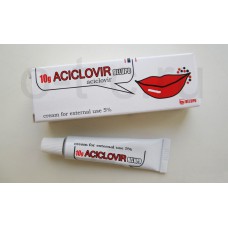Expiration dates: 06/2022
Structure and Composition:
Tablets, film-coated. One tablet contains acyclovir 400 mg
Excipients:
tablet core: povidone, sodium carboxymethyl MCC colloidal silicon dioxide Magnesium stearate
shell tablet: Opadry Pink OY24926 (hypromellose, titanium dioxide, macrogol, iron oxide red dye, yellow dye iron oxide)
in blisters 7 pcs. In the paper cartons five packs.
Cream for topical application 1 g of 5%
acyclovir 50 mg
Excipients: glyceryl monostearate and propylene glycol mixture and macrogol stearate 100 cetostearyl alcohol (60% cetyl alcohol, stearyl alcohol, 40%) Mineral Oil Petrolatum sodium lauryl water, hydrochloric acid
in aluminum tubes 10 g per 1 cardboard tube bundle.
Description pharmaceutical form:
Tablets: elliptical, film-coated, pale pink color.
Cream white, homogeneous, without mechanical impurities.
Pharmacokinetics:
When ingestion bioavailability is 15-30%. Acyclovir well penetrates into all organs and tissues, including the brain and skin. Plasma protein binding amounts to 9-33% and is independent of its concentration in plasma. concentration in CSF is about 50% of its concentration in plasma. Acyclovir crosses the placental barrier and accumulates in breast milk. Cmax after administration into 200 mg 5 times a day - 0.7 mg / ml, Tmax - 1,5-2 hours.
It is metabolized in the liver to pharmacologically inactive compounds - 9 karboksimetoksimetilguanina.
T1 / 2 in adults with normal renal function is 2-3 hours in patients with severe renal insufficiency T1 / 2 -. 20 hours, during hemodialysis - 5.7 hours (the concentration acyclovir in the plasma is reduced to 60% of the initial value ).
About 84% excreted by the kidneys in unchanged form and 14% - in the form of metabolites. Renal clearance of aciclovir is 75-80% of the total plasmatic clearance. Less than 2% acyclovir is excreted from the body through the intestines.
Cream. When applied to intact skin: not determined minimum absorption in the blood and urine of the affected skin: mild suction.
Description of the pharmacological actions:
Acyclovir - an antiviral drug, a synthetic analogue of the acyclic purine nucleoside - dezoksiguanidina with a highly selective effect on herpes viruses and is a component of DNA. Inside the virus-infected cells by the viral thymidine kinase is a series of successive transformation reactions acyclovir mono-, di- and triphosphate of acyclovir. Acyclovir triphosphate is incorporated into the viral DNA chain, and blocking its synthesis by competitive inhibition of viral DNA polymerase. Thus, a defective viral DNA replication which leads to suppression of generation of new viruses.
In vitro acyclovir effective against herpes simplex virus - Herpes simplex type I and II, Varicella zoster virus against higher concentrations required for inhibition of Epstein-Barr virus. In vivo acyclovir therapeutically and prophylactically effective especially in viral infections caused by Herpes simplex.
Testimony:
Pills
treatment of infections of the skin and mucous membranes caused by Herpes simplex viruses types I and II, both primary and secondary, including genital herpes.
prevention of recurrent exacerbations, infections caused by viruses Herpes simplex type I and II, in patients with normal immune status of patients
prophylaxis of primary and recurrent infections caused by Herpes simplex viruses types I and II, in immunocompromised patients.
in the complex therapy of patients with severe immunodeficiency: HIV infection (AIDS stage, the early clinical manifestations and developed clinical picture) and in patients undergoing bone marrow transplantation
treatment of primary and recurrent infections caused by the virus Varicella zoster (chickenpox and shingles - Herpes zoster).
Cream
Skin infections caused by Herpes simplex virus types I and II, the genital herpes, herpes zoster, chickenpox.
Contraindications:
Tablets and cream:
- Hypersensitivity to acyclovir, ganciclovir, famciclovir, valacyclovir, or any excipient product.
- For tablets additionally:
- lactation
- Children up to age 3 years.
Carefully:
- dehydration
- kidney failure
- neurological disorders, including history.
Application of pregnancy and breastfeeding:
Pills and Cream
Use during pregnancy is possible only when the intended benefits to the mother outweighs the potential risk to the fetus.
Acyclovir crosses the placental barrier and accumulates in breast milk. If you want to receive acyclovir during lactation require interruption of breastfeeding.
Side effect:
Pills
The drug is generally well tolerated.
On the part of the digestive tract: in rare cases - abdominal pain, nausea, vomiting, diarrhea.
Laboratory tests: passing a slight increase in liver enzymes, rarely - a small increase in levels of urea and creatinine, hyperbilirubinemia, leukopenia, erythropenia.
CNS: rarely - headache, weakness in some cases, tremor, dizziness, fatigue, drowsiness, confusion, hallucinations, paresthesia, agitation.
Allergic reactions: anaphylactic reactions, allergic skin reactions (itching, Lyell's syndrome, urticaria, erythema multiforme exudative, including Stevens-Johnson syndrome), peripheral edema.
Other: rare - alopecia, fever, myalgia, blurred vision, lymphadenopathy.
Cream
Hyperemia, dryness, peeling, burning of the skin, inflammation in contact with mucous membranes. Perhaps the development of atopic dermatitis.
Drug Interactions:
Pills
Concomitant use with probenecid increases the mean half-life and reduced clearance of acyclovir.
When concomitantly with nephrotoxic drugs increases the risk of renal dysfunction.
Enhancing observed with concomitant administration of immunostimulants.
Cream
Perhaps strengthening effect while the appointment of an immunostimulant.
Dosage and administration:
Pills
Inside, during or immediately after a meal, drinking plenty of water.
Treatment should begin as soon as possible, immediately after the first symptoms.
The dosage is determined individually depending on the severity of the disease.
In treating infections of the skin and mucous membranes caused by Herpes simplex types I and II, for adults and children over three years of drug prescribed 200 mg five times daily for 5 days with the 4-hour intervals during the day and 8 hour intervals for night. In more severe cases, the disease course of treatment can be extended by a physician.
In the combined therapy in patients with severe immunodeficiency, including HIV infection (AIDS stage, early clinical manifestations and clinical unfolded) after implantation of bone marrow administered 400 mg 5 times per day.
For the prevention of recurrence of infections caused by Herpes simplex viruses types I and II, in patients with normal immune status and disease relapse prescribed 200 mg four times a day every six hours.
For the prevention of infections caused by Herpes simplex virus type I and II, the adults and children over 3 years of immunocompromised, the drug is recommended to appoint 200 mg 4 times a day, every 6 hours, maximum dose - 400 mg of acyclovir 5 times a day, depending on the severity of the infection.
In the treatment of infections caused by Varicella zoster, adult 800 mg administered 5 times a day every 4 hours during the day and 8-hour intervals over night. The duration of treatment 7-10 days. Children older than 3 years appoint 20 mg / kg 4 times a day for 5 days, children weighing more than 40 kg of drug administered in the same dosage as adults.
In the treatment of infections caused by Herpes zoster, adult 800 mg administered 4 times a day, every 6 hours for 5 days.
In patients with impaired renal function:
In the treatment and prevention of infections caused by Herpes simplex, in patients with a creatinine clearance less than 10 mL / min, the dosage should be reduced to 200 mg two times a day at 12-hour intervals.
In the treatment of infections caused by Varicella zoster, in patients with a creatinine clearance less than 10 mL / min is recommended to reduce the dosage to 800 mg two times a day at 12-hour intervals at Cl creatinine to 25 ml / min is assigned by 800 mg three times a day with 8-hour intervals.
Cream for external use
Outwardly. The drug is applied to the damaged areas of the skin 5 times daily (every four hours) with a thin layer and adjacent to the affected skin with them. The cream is applied with a cotton swab or clean hands, to avoid further infection lesions. Therapy should continue until such time until the bubbles do not form a crust, or until they are completely healed. Duration of treatment - at least 5 days, a maximum - 10 days.
Overdose:
Pills
Symptoms: oral intake of 20 g of acyclovir does not cause specific symptoms. Can show side effects from the CNS - convulsions, tremor, lethargy.
Treatment: it is necessary to induce vomiting (preferably within 30 minutes after dosing) and take absorbents. In the case of acute renal failure and anuria - maintaining vital functions, hemodialysis.
Special instructions:
Pills
Prolonged or repeated treatment with acyclovir patients with reduced immunity could lead to the emergence of virus strains that are insensitive to its action. Apply strictly prescribed by a doctor to avoid complications in adults and children over 3 years.
Be wary appoint patients with impaired renal function, elderly patients due to increased half-life of acyclovir.
In applying the drug is necessary to ensure a sufficient amount of liquid.
When receiving the drug should monitor kidney function (blood level of urea and creatinine in blood plasma).
Cream
To achieve maximum therapeutic effect of the drug should be started as soon as possible after the onset of infection (at the first signs of the disease: burning, itching, tingling, a feeling of tension and redness). Cream should not be applied on the mucous membranes of the mouth and eyes, as may develop pronounced local inflammation.
Tablets cream
Acyclovir does not prevent the transmission of sexually transmitted herpes, so the period of treatment should refrain from sexual intercourse, even in the absence of clinical manifestations.



